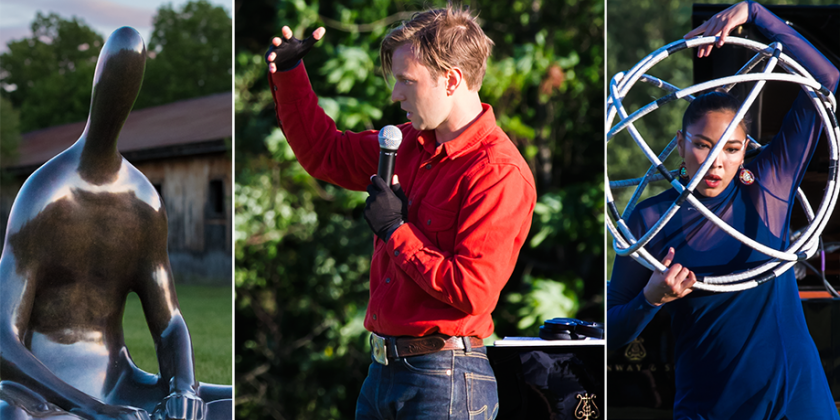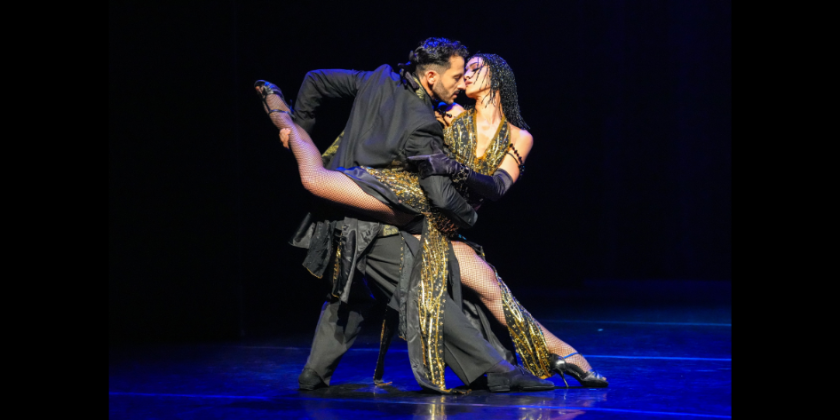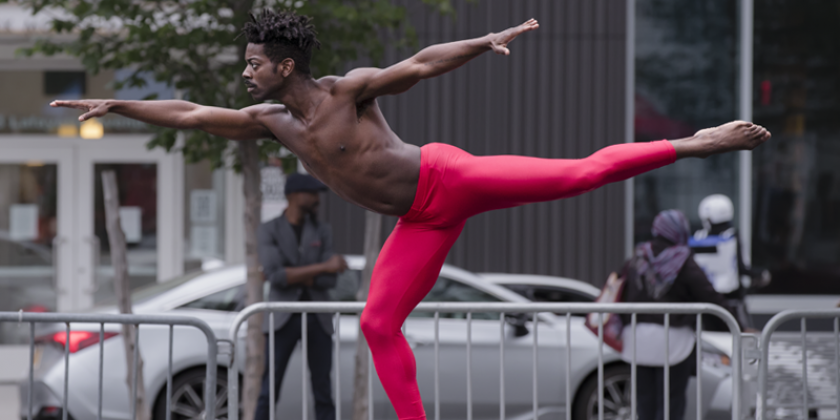DAY IN THE LIFE OF DANCE: With Gratitude, Looking Back at AMERICAN LYRIC, a Commission by Kaatsbaan Cultural Park- Considering Nature, Music, Dance and Native American Heritage

Pianist Hunter Noack, Known for his Series "IN A LANDSCAPE: Classical Music in the Wild" Collaborates with Dancers Garen Scribner, Coral Dolphin, ShanDien LaRance,Or Schraiber,and Taylor Stanley
The Dance Enthusiast caught up with renowned concert pianist, Hunter Noack, who performed his series, IN A LANDSCAPE: Classical Music in the Wild, as part of AMERICAN LYRIC, which premiered at the Kaatsbaan Cultural Park, May 27th, 2021.
A live audience listened via Bluetooth headset as Noack played cascading melodies by Saint-Saens, Liszt, Ravel, Chopin, and Debussy as well as the illuminary Kara Toprak/Black Earth by Fazil Say; and John Cage's hypnotic homage to Erik Satie, In A Landscape. Five dancers performed self-choreographed pieces as part of the event.

Says Noack, “AMERICAN LYRIC commissioned by the KAATSBAAN FESTIVAL, was a first-time collaborative project between Garen Scribner's GAREN MEDIA, and myself, being artistic director and pianist of IN A LANDSCAPE: Classical Music in the Wild. Even though I had previously been involved in ballet projects with Oregon Ballet Theater, Pacific Northwest Ballet, and choreographers such as Nicolo Fonte, (Giants Before Us - being my first in 2016) what I loved about AMERICAN LYRIC and the KAATSBAAN experience was working with Garen and the intimacy of having direct conversations with the dancers."

"What's most inspiring is the first chapter and what speaks to a particular dancer or choreographer. As a musician, I can't be as expressive through my body, because my fingers are on the keyboard, and I'm sitting on a bench," says Noack. " It is such a fun to work with another human who can run and leap or hide and crawl. It's the ‘music of movement’ which draws me to the genre of dance.”


One of the Kaatsbaan AMERICAN LYRIC dancers was ShanDien LaRance, who is Hopi-Assiniboine and Tewa-Navajo. Interwoven with Noack's piano adaptations were pre-recorded renditions by flutist James Edmund Greeley, who is from The Confederated Tribes of Warm Springs and the Hopi Nation.

Says Noack, “My concerts feature several different Native Americans – from poets to dancers, and other guest artists. Hopi flutist, James Edmund Greeley, has been the impetus for my performing improvisation. Our longtime music partnership and our new album in-process reminds me how choreographer Merce Cunningham and (composer) John Cage created rhythmic structure together.
Music and dance would come together at points, but then the spaces in between was whatever the dance decided to be or the music intended to be were not necessarily married together. This sums how James Greeley and I improvise within structural parameters. Within those streams of consciousness, we are pulling whatever we're inspired by into these moments... “

“What was great about working with ShanDien LaRance was that it was new for both of us. I had never been involved with creating classical music to Native American dance. After learning from her about the origins of Hoop Dance; watching her videos; and observing that traditional drums had certain beats per minute; I looked for different pieces that I felt had that same kind of pulse.”
Says LaRance, "The KAATSBAAN FESTIVAL was my first time performing to classical music and I loved every second of the preparation for this blending of cultures. Hunter sent me six songs to choose from; and Debussy’s Gardens in the Rain really stood out. What I enjoyed dancing to were its changes of rhythm and tempo both in the musical aspect and for my footwork. Traditional Hoop Dance is constant movement. Debussy requires moments to breathe and be still - the challenge being to adjust as the music transitioned from fast to slow."
"When you watch a hoop dancer from any tribal background, you will see many animals and figures in our dances... the eagle, the butterfly, the crocodile or serpent; the cowboy riding the horse... All these shapes have meaning in our traditions. In my Hopi and Tewa culture we honor the eagles and hawks as sacred beings. Same for the butterfly, which represents the insects, the plants, and pollination (as) transitions of life."

ShanDien LaRance shapes with her hoops an eagle in flight | Photo: Serena S.Y. Hsu / ZUMA Press

ShanDien LaRance’s hoops take on the delicate qualities of the butterfly in the more meditative sections of Claude Debussy's Gardens in the Rain. | Photo: Serena S.Y. Hsu / ZUMA Press
"In a homeland, where water is precious and scarce," says LaRance, “we pray for rain from our ancestors. I am both Navajo and Hopi. In Hopi culture we are taught that our ancestors become the clouds and bring us rain. In Navajo we are told not to run or shield ourselves from the rain, otherwise)the rain will leave. My ancestors walked, ran, played and harvested the tribal lands of Ohkay Owingeh, New Mexico, with the rivers that run and the trees and earth there ─ and I can feel that energy when I am home."

For Noack, the spirituality of Native America is deeply rooted in both nature and storytelling; a call-and-response that is deeply diverse and compelling.


Noack also finds beautiful lyricism with Fazil Say, a Turkish composer and pianist who interweaves the folk music and the poetry of his homeland into classical music compositions. "In 2013, while I was living in London, I saw Say perform with violinist Patricia Kopatchinskaja. What captivated me was how much Say and Kopatchinskaja seemed to dance as (they) swayed to the music and how they seemed to deeply communicate between each other with those movements. "
"I feel like conductors are dancers because they're communicating with physical movement. Their bodies are telling (the orchestra) what is happening with the music or what needs to be done to the music. I grew up with the type of training that shunned physical expression from the performer, sitting at a piano. But the older I get, I love seeing musicians as conductors, in a sense, because we have to find ways to work outside the confines of our own body to communicate our inner selves."

"Fazil Say's musical interpretation of Kara Toprak/Black Earth was inspired by a very old poem by Turkish Âşık Veysel, which is still relevant today," says Noack. It is about a man's relationship to cultivating the earth. Say wished to lay bare the intrinsic connection between the heart and nature... and our responsibility to respect the land on which we live.


" I love seeing how, with certain dances, we set up expectations (for the audience), and either satisfy those or play with them," says Noack. "With ShanDien, there's a very clear story. Whereas in something like John Cage's In a Landscape [danced by Coral Dolphin] or Fazil Say's Black Earth [danced by Or Schraiber] - those two pieces have a Merce Cunningham and John Cage vibe, where the music and dance change apart, like the weather."




"I love the visual time dynamism of nature. I love to play piano during those hours before the sun comes up, and just as it's setting. The shifting of the skies creates those dramatic changes that help us to see more vividly how everything is about change. If we're near water, then I'll have people stick their toes in the water. I love programming pieces that give people some sort of sensory activity during my performances."

With his ongoing concert series, IN A LANDSCAPE: Classical Music in the Wild, Noack invites audiences the world over to participate in the music of nature; to return to the earth; and to find inspiration from Native America.
"Time is what music gives us to contemplate our own inner landscape..."

The Kaatsbaan American Lyric concludes with the finale, Piano Concerto in G. Adagio assai by Maurice Ravel. Performers from l-r: Coral Dolphin, Or Schraiber, ShanDien LaRance, Hunter Noack, Taylor Stanley, Garen Scribner.














